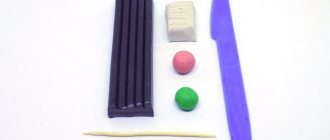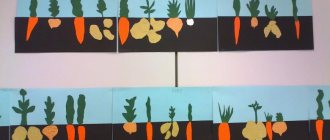Internal organs
To familiarize yourself with internal anatomy, we recommend taking several informative lessons. It will be easier for the baby to fold by referring to schematic drawings of this kind.
Repeat the name of each organ out loud to learn how to pronounce it correctly and remember it faster. For initial preparation, a simple paper creation and printed blanks are suitable.
Remember that it is worth distinguishing between ages, so start studying with preschoolers. For convenience and to speed up the preparation process, organ templates can be made from plasticine and laid out on an image of the body, which is used as the basis for the craft.
When your baby gets comfortable with the basics, make the task more difficult:
- From cardboard or thick felt of different colors, cut out the body, organs and main skeleton.
- Stock up on adhesive tape. Cut it into small squares. Glue or sew pieces of the lower part in certain areas on the body, and pieces of the upper part - on organs and bones.
The result will be a kind of educational game.
A multi-layer product is a fascinating and educational thing with a reusable function. The elements involved in it are attached with Velcro, which is very convenient. We hope that our lessons were useful to you.
On the topic: methodological developments, presentations and notes
Often, not everyone in their preschool educational institutions can purchase the necessary equipment; unfortunately, insufficient funding in our rural areas is progressing. Maybe someone will find my ideas on sports events useful.
Prevention of childhood injuries is one of the most important tasks of modern society, which must be achieved primarily by observing safety precautions in physical education classes.
The didactic game develops visual attention and logical thinking. It will also help consolidate children’s knowledge about different sports, athletes, and sports attributes.
Presentation of work experience.
The material is intended for children of senior preschool age. Can be used in educational activities and in organizing leisure time.
SOD summary for the production of collective work using the 3D appliqué technique “Sport - health, sport - game”.
Tatyana Titova Summary of SOD for the production of collective work using the technique of volumetric application “Sport - health, sport - game”
Man in motion: people in different poses
The main elements for implementing this technique are shapes: squares, rectangles and wide stripes. Therefore, this technique partially relates to geometric appliqué. The easiest way is to prepare blanks for the first trial work from a notebook sheet in a box. There are already markings there, you just need to cut out the necessary shapes.
As a lesson, explain how certain parts of the body are depicted during movement. Why does this happen and for what purpose? From a number of similar works on a specific topic, you can make an entertaining panel dedicated to sports, family relationships or friends.
MAGAZINE Preschooler.RF
Summary of educational activities on application in the senior group “Winnie the Pooh” using health-saving technologyMunicipal autonomous preschool educational institution of the municipal formation of Krasnodar "Center - kindergarten No. 182"
Educator: Perminova A.A.
Tasks:
1. Educational:
- Teach children to create a three-dimensional application of a toy from parts, correctly conveying their relative size.
- mastering cutting techniques, using various methods of attaching material to the background to obtain a volumetric applique.
2. Developmental:
- Develop creative abilities; develop visual control of hand actions, give each child the opportunity to exercise independence in choosing ways to decorate their work.
3. Educational:
- Cultivate friendly attitudes towards others; to generate interest in the application based on the model.
- Strengthen the ability to cut out parts of round and oval shapes, carefully paste the image, and arrange it beautifully on a sheet of paper.
Equipment: scissors, stand for scissors, brush, socket with paste, napkin, stand for brush, box for scraps, tray with parts for toys, oilcloth, yellow cardboard the size of a landscape sheet, sample, natural material (watermelon seeds, melon), buttons.
Progress of the lesson.
Educator:
-Guys, a letter came to our group, and from whom you will find out when you guess the riddle:
He is cheerful and gentle
This cute weirdo
For him, a walk is a holiday
And I have a special scent for honey
This is a plush prankster
Little bear. (Winnie the Pooh)
-Let's read the letter, what does he write? “Dear guys, please take a lot of my photos, I want to give them to my friends, I need to do it before winter. Thank you in advance Winnie the Pooh"
Guys, why is he asking to do it before winter? (bears sleep in winter) where do they sleep? (in the den)
In order for the photos to turn out well, let's look at it carefully.
Is the piece of paper positioned vertically or horizontally? (vertical)
In which part of the sheet is the image of Winnie the Pooh? (in the middle of the sheet)
What body parts does the Winnie the Pooh image consist of? (head, torso, upper and lower paws)
What details are there on the head? (ears, nose, mouth, eyes)
What shape is the head? (round)
Are there body parts of the same shape? (torso)
What geometric shape do the paws resemble? (oval), are there objects of the same shape in the photograph (balloon). What shape do the ears look like? (semicircle)
From which square will we cut the body? Why do you think so? (it's large) Show it on the easel.
What size square do we need for the head? (slightly less)
What detail should we start taking photos with? (from the body)
In what part of the sheet will the body be located? (slightly below the middle of the sheet)
Where will the head be located? (in the upper part of the body, on the head - ears)
Where will the upper legs be located? (right and left of the body, and the lower legs in the lower part of the body)
Notice how the teddy bear's paws move, how should you glue the parts? (glue the tip of the part)
Now that we have looked at the image of the teddy bear, let's remember how to cut out the parts (sit at the tables)
I show and explain how to cut a circle from a square.
Who can tell me how to fold a rectangle to make two squares? (in half) what can we cut out of the square? (ears), how? (round top corners)
And in order for the paws to be the same size, you need to fold a rectangular sheet of paper in half and in half again and cut out one part, you will get 4 oval-shaped paws.
How to cut an oval from a rectangle? (round all four corners).
Where do we start? (cut out all the details, lay out the image on a sheet of paper and then paste it on)
Guys, you will find the details of the face (nose, mouth, eyes) on the tray, which are made and, if you have time, you can make grass and a balloon.
We've looked at everything, I'm sure you'll take wonderful photos.
Get to work.
After cutting out all the parts
physical education minute
A bear wanders through the forest, walking from oak to oak. (Waddle)
He finds honey in the hollows and puts it in his mouth. ( "Get" honey with your hand)
The clubfoot licks the paw of a sweet tooth, (Imitation of movement)
And the bees swoop in and drive the bear away. ( "Waving away" the bees)
And the bees sting the bear: “Don’t eat our honey, thief . (Lightly pinch your nose and cheeks)
A bear wanders along a forest road to his den. (Waddle)
He lies down, falls asleep and remembers the bees. (Hands under the cheek, tilt your head)
Reflection: at the end of the lesson, review and evaluate all works, select the most interesting, expressive, and original. Everyone tried their best, I think the little bear will be happy. What was difficult to do? What's easy? What did you learn today? What can you do with the work? (Insert in a frame, hang on the wall).
| Next > |
Anatomy for kids: geometric shapes
The simplest instructions that will be understandable to children of primary and secondary kindergarten age. The work should be done under the supervision of an adult, who will voice each part of the body, show it to the baby himself and supervise the entire process of creating the craft. The more elements, the more difficult the task will be, so you should start with the simplest models.
From simple geometric shapes you can make a full-fledged postcard, the main character of which will be any family member.
Bright and cheerful images will certainly appeal to children of primary preschool age.
For those who are older, a unique mosaic composition is suitable. For example, from the proposed stencil you can make blanks for a future picture.
Invite your child to assemble a little man from the resulting elements, gluing them in a certain sequence on the base sheet.



